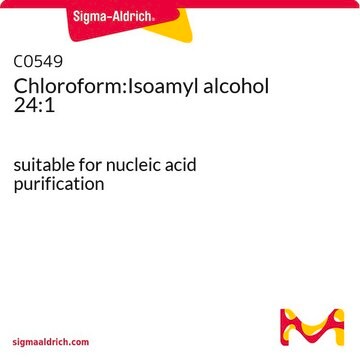W205702
Isoamyl alcohol
≥98%, FG
Synonim(y):
3-Methyl-1-butanol, Isoamyl alcohol, Isopentyl alcohol
About This Item
Polecane produkty
pochodzenie biologiczne
synthetic
Poziom jakości
klasa czystości
FG
Halal
Kosher
agency
meets purity specifications of JECFA
zgodność regionalna
EU Regulation 1334/2008 & 178/2002
FDA 21 CFR 117
FDA 21 CFR 172.515
gęstość pary
3 (vs air)
ciśnienie pary
2 mmHg ( 20 °C)
Próba
≥98%
Postać
liquid
temp. samozapłonu
644 °F
granice wybuchowości
1.2-9 %, 100 °F
współczynnik refrakcji
n20/D 1.406 (lit.)
pH
5.6 (20 °C, 25 g/L)
tw
130 °C (lit.)
mp
−117 °C (lit.)
gęstość
0.809 g/mL at 25 °C (lit.)
Zastosowanie
flavors and fragrances
Dokumentacja
see Safety & Documentation for available documents
alergen pokarmowy
no known allergens
Organoleptyczne
banana; oily; fruity; whiskey
ciąg SMILES
CC(C)CCO
InChI
1S/C5H12O/c1-5(2)3-4-6/h5-6H,3-4H2,1-2H3
Klucz InChI
PHTQWCKDNZKARW-UHFFFAOYSA-N
Szukasz podobnych produktów? Odwiedź Przewodnik dotyczący porównywania produktów
Opis ogólny
Zastosowanie
- Chemotaxis assay for evaluation of memory-like behavior in wild-type and Alzheimer′s-disease-like C.elegans models.: While not directly related to isoamyl alcohol, this study uses a methodology that can be adapted for studies involving isoamyl alcohol effects on cellular processes (Fang EF et al., 2023).
Hasło ostrzegawcze
Danger
Zwroty wskazujące rodzaj zagrożenia
Zwroty wskazujące środki ostrożności
Klasyfikacja zagrożeń
Acute Tox. 4 Inhalation - Eye Dam. 1 - Flam. Liq. 3 - Skin Irrit. 2 - STOT SE 3
Organy docelowe
Respiratory system
Kod klasy składowania
3 - Flammable liquids
Klasa zagrożenia wodnego (WGK)
WGK 1
Temperatura zapłonu (°F)
110.3 °F - closed cup
Temperatura zapłonu (°C)
43.5 °C - closed cup
Środki ochrony indywidualnej
Eyeshields, Faceshields, Gloves, type ABEK (EN14387) respirator filter
Certyfikaty analizy (CoA)
Poszukaj Certyfikaty analizy (CoA), wpisując numer partii/serii produktów. Numery serii i partii można znaleźć na etykiecie produktu po słowach „seria” lub „partia”.
Masz już ten produkt?
Dokumenty związane z niedawno zakupionymi produktami zostały zamieszczone w Bibliotece dokumentów.
Klienci oglądali również te produkty
Nasz zespół naukowców ma doświadczenie we wszystkich obszarach badań, w tym w naukach przyrodniczych, materiałoznawstwie, syntezie chemicznej, chromatografii, analityce i wielu innych dziedzinach.
Skontaktuj się z zespołem ds. pomocy technicznej








